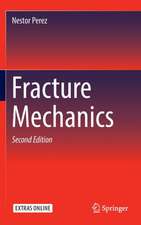Elastic-Plastic Mixed-Mode Fracture Criteria and Parameters: Lecture Notes in Applied and Computational Mechanics, cartea 7
Autor Valery N. Shlyannikoven Limba Engleză Hardback – 27 noi 2002
| Toate formatele și edițiile | Preț | Express |
|---|---|---|
| Paperback (1) | 638.43 lei 6-8 săpt. | |
| Springer Berlin, Heidelberg – 28 iul 2012 | 638.43 lei 6-8 săpt. | |
| Hardback (1) | 650.55 lei 6-8 săpt. | |
| Springer Berlin, Heidelberg – 27 noi 2002 | 650.55 lei 6-8 săpt. |
Din seria Lecture Notes in Applied and Computational Mechanics
- 19%
 Preț: 422.95 lei
Preț: 422.95 lei - 18%
 Preț: 1008.12 lei
Preț: 1008.12 lei - 18%
 Preț: 1120.18 lei
Preț: 1120.18 lei - 20%
 Preț: 560.82 lei
Preț: 560.82 lei - 18%
 Preț: 948.16 lei
Preț: 948.16 lei - 24%
 Preț: 1567.86 lei
Preț: 1567.86 lei - 15%
 Preț: 643.65 lei
Preț: 643.65 lei - 18%
 Preț: 956.81 lei
Preț: 956.81 lei - 18%
 Preț: 957.62 lei
Preț: 957.62 lei - 15%
 Preț: 649.87 lei
Preț: 649.87 lei - 18%
 Preț: 1224.54 lei
Preț: 1224.54 lei - 18%
 Preț: 956.50 lei
Preț: 956.50 lei - 18%
 Preț: 954.45 lei
Preț: 954.45 lei - 18%
 Preț: 948.92 lei
Preț: 948.92 lei - 18%
 Preț: 949.55 lei
Preț: 949.55 lei - 15%
 Preț: 644.49 lei
Preț: 644.49 lei - 18%
 Preț: 1234.62 lei
Preț: 1234.62 lei - 18%
 Preț: 777.69 lei
Preț: 777.69 lei - 18%
 Preț: 1221.83 lei
Preț: 1221.83 lei - 15%
 Preț: 643.00 lei
Preț: 643.00 lei - 18%
 Preț: 956.33 lei
Preț: 956.33 lei - 15%
 Preț: 640.88 lei
Preț: 640.88 lei - 15%
 Preț: 645.79 lei
Preț: 645.79 lei - 18%
 Preț: 944.99 lei
Preț: 944.99 lei - 18%
 Preț: 956.18 lei
Preț: 956.18 lei - 18%
 Preț: 1236.69 lei
Preț: 1236.69 lei - 18%
 Preț: 953.97 lei
Preț: 953.97 lei - 15%
 Preț: 640.88 lei
Preț: 640.88 lei
Preț: 650.55 lei
Preț vechi: 765.36 lei
-15% Nou
Puncte Express: 976
Preț estimativ în valută:
124.48€ • 129.98$ • 102.79£
124.48€ • 129.98$ • 102.79£
Carte tipărită la comandă
Livrare economică 15-29 aprilie
Preluare comenzi: 021 569.72.76
Specificații
ISBN-13: 9783540443162
ISBN-10: 3540443169
Pagini: 256
Ilustrații: VIII, 246 p. 324 illus.
Dimensiuni: 155 x 235 x 19 mm
Greutate: 0.7 kg
Ediția:2003
Editura: Springer Berlin, Heidelberg
Colecția Springer
Seria Lecture Notes in Applied and Computational Mechanics
Locul publicării:Berlin, Heidelberg, Germany
ISBN-10: 3540443169
Pagini: 256
Ilustrații: VIII, 246 p. 324 illus.
Dimensiuni: 155 x 235 x 19 mm
Greutate: 0.7 kg
Ediția:2003
Editura: Springer Berlin, Heidelberg
Colecția Springer
Seria Lecture Notes in Applied and Computational Mechanics
Locul publicării:Berlin, Heidelberg, Germany
Public țintă
ResearchCuprins
I. Mixed-mode crack behavior under plane stress and plane strain small scale yielding.- 1.1 Governing equations.- 1.2 Numerical iterative method for solving the nonlinear eigenvalue problems.- 1.3 Application of J-integral to plastic stress intensity factor determination.- 1.4 Family of crack-tip fields characterized by dominating fracture mechanism.- 1.5 Finite element analysis of stress distributions at the crack tip.- 1.6 Conditions of existence for mixed mode fracture.- II. Modeling of crack growth by fracture damage zone.- 2.1 A modified strain-energy density approach.- 2.2 Strain energy density distributions.- 2.3 Fracture damage zone.- 2.4 Relation between cracks growth resistance and fracture process parameters in elastic-plastic solids.- 2.5 Elastic-plastic approach for modeling of fatigue crack behavior.- 2.6 Some aspects of the fatigue crack path prediction.- III. Experimental investigation of fatigue crack propagation.- 3.1 Specimens for study of fatigue and fracture processes and material properties.- 3.2 Method of interpretation for cyclic crack resistance characteristics.- 3.3 Effect of biaxial stress on fatigue crack growth in aluminum alloys.- 3.4 Influence of mixed mode loading on fatigue fracture of high strength steels.- 3.5 Fatigue crack growth trajectories for the aluminum alloys and steels.- IV. Models for predicting crack growth rate and fatigue life.- 4.1 Crack growth direction criterion.- 4.2 Criteria of equivalent plastic strain under a complex stress state.- 4.3 A model for predicting crack growth rate under biaxial loads.- 4.4 An analysis of crack growth under complex stress state with taking into account their orientation.- V. Practical applications.- 5.1 Fracture analysis of gas turbine engine disks and simulation modeling of operational conditions.- 5.2 Modeling fatigue crack behavior in a pressurized cylinder.- Reference.
Textul de pe ultima copertă
This book contains an elastic-plastic analysis of accumulate damage and fracture with practical applications to engineering materials and structure fatigue life estimations. Models as well as practical applications are presented which makes the book interesting for both practitioners and theoretical researchers. Particular emphasis is laid on new approaches to the mixed-mode problem in fatigue and fracture, and especially to the fracture damage zone (FDZ) approach. The results of the demonstrated experimental and theoretical researches leads to the presentation of different crack growth models, predicting the crack growth rate and fatigue life of an initially angled crack under biaxial loads of arbitrary direction. Special attention is paid to the practical applications of the suggested models.
Caracteristici
Crack propagation for practitioners and theoretical researchers













